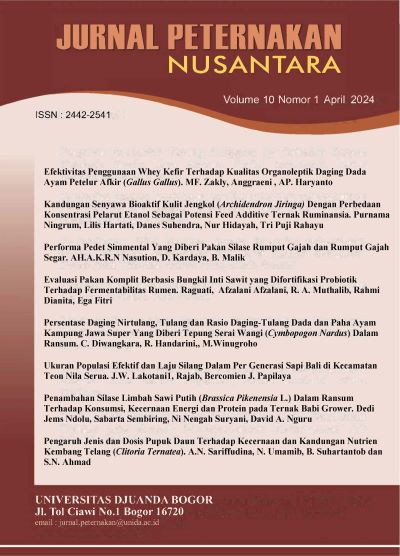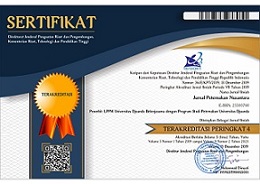THE CONTENT OF BIOACTIVE COMPOUNDS IN JENGKOL SKIN (ARCHIDENDRON JIRINGA) WITH DIFFERENT CONCENTRATIONS OF ETHANOL SOLVENT AS A POTENTIAL FEED ADDITIVE FOR RUMINANT LIVESTOCK
KANDUNGAN SENYAWA BIOAKTIF KULIT JENGKOL MENGGUNAKAN PERBEDAAN KONSENTRASI PELARUT ETANOL
DOI:
https://doi.org/10.30997/jpn.v10i1.10839Keywords:
Ethanol, Bioactive Compounds, Jengkol Peel,Abstract
This study was aimed to determine the content of bioactive compounds in jengkol peel (Archidendron Jiringa) with different concentrations of ethanol as a potential feed additive for ruminants. The material used in this study was 50g jengkol peel flour in each treatment. The research method used was an experimental trial using a Completely Randomized Design (RAL) with 5 treatments and 4 replications. The treatments used were P1 (100% aquadest), P2 (24% ethanol (75% aquadest + 25% ethanol)), P3 (48% ethanol (50% aquadest + 50% ethanol)), P4 (72% ethanol (25% aquadest + 75% ethanol)), and P5 (96% ethanol (100% ethanol)). The parameters observed in this study were tannin content, saponin, flavonoid, and total phenol. The data obtained were analyzed using Analysis of Variance (ANOVA), then if there were significantly differences, Duncan Multiple Range Test (DMRT) was carried out. The results of the study of jengkol peel extract using ethanol solvents with different concentrations gave significantly different results of tannin and saponin content (P<0.05), while the flavonoid content and total phenol were not significantly different (P>0.05).
Based on the research conducted, it is concluded that jengkol peel extract has the potential as a feed additive for ruminants, as evidenced by the results of the tannin content of 8,22% and the saponin content of 13,47% with an ethanol concentration of 48%, but did not affect the flavonoid content and total phenol extracted from jengkol peel (Archidendron jiringa).
Downloads
References
Adhayanti, I., T. Abdullah, dan R. Romantika. 2018. Uji kandungan total polifenol dan flavonoid ekstrak etil asetat kulit pisang raja (Musa paradisiaca var.sapientum). Media Farmasi, 14(1): 39-45.
Agustina, R. 2006. Penggunaan Ramuan Herbal Sebagai Feed Additive Untuk Meningkatkan Performan Broiler. Prosding Lokal Nasional. Inovasi Teknologi Dalam Mendukung Usaha Ternak Unggas Berdaya Saing. Pusat Penelitian dan Pengembangan Peternakan. Bogor.
Ayoma, S dan Y. Yamamoto. 2007. Antioxidant acitivity and flavonoid content of wels onion (Allium fistulosum) and the affectof thermal treatment. Journal Food Science Technology Research, 13(1): 67-68.
Bernard, D., A.I Kwabena., O.D Osei., G.A Daniel., S.A Elom., dan A. Sandra. 2014. The effect of different drying methods on the phytochemicals and radical scavenging activity of Ceylon cinnamon (Cinnamomum zeylanicum) plant parts. Journal Of Medicinal Plants, 4(11): 1324-1335.
Bhat, R, dan N.B Yahya. 2014. Evaluating Belinjau (Gnetum gnemon L.) seed flour qualityAsa base for development of novel food product and food formulations. Journal Food Chemistry. 156 42-49.
Buhian, W.P.C., R.O Rubio., D.L. Valle., J.J.M Puzon. 2016. Bioactive metabolite profiles and antimicrobial activity of ethanolic extract from (Muntingia calabura L.) leaves and stems. Journal Of Tropical Biomedicine, 6(8): 682-685.
Chaovanalikit, A., dan R.E. Wrolstad. 2004. Total anthocyanins and total phenolics of fresh and processed cherries and their antioxidant properties, Journal of Food Science, 69(1): 67-72.
Chan, E.W.C., Y.Y Lim., S.K Wong., K.K Lim., S.P Tan., F.S Lianto., M.Y Yong. 2009. Effects of different drying methods on the antioxidant properties of laves and tea of ginger species. Journal Of Agriculture and Food Chemistry, 113:166-172.
Chayati, I., Sunarti, Y. Marsono, dan M. Astuti. 2020. Pengaruh varietas, fraksi pengayakan, dan jenis pelarut terhadap kadar antisionin, fenolik total, dan aktivitas antioksidan ekstrak jagung ungu. Jurnal Riset Teknologi Industri, 14(1): 13-26.
Cotton, F.A, G.Wilkinson. 1989. Basic Inorganic Chemistry. Edition3. John Wiley and Sons, New York.
Donkor, ES, J.N. Mercy., C.K.T Sammy., T.K.D.D. Nocholas., B. Elizabeth, dan O. Michael. 2011. Investigation into the risk of exposure to antibiotic residue contaminating meat and egg in Ghana. Journal Food Control, 22:869-873
Febrina, L.,Rolan, dan R., Fairul. 2015. Optimalisasi Ekstraksi dan Uji Metabolit Sekunder Tumbuhan Lib (Ficus variegate blume). Journal Tropical Pharmacy Cheistrym, 3(2): 74-81.
Firdiyani, F., W.A., Tri, dan F.M. Widodo. 2015. Ekstraksi senyawa bioaktif sebagai antioksidan alami Spirulina platensis using Different Solvents. Journal Pengolahan Hasil Perikanan, 18 (1): 28-37.
Friden, T. 2013. Antibiotic Resistence Threats in the United States. 2013. U.S. Centeres for Disease Control and Prevention
Harbone, J.B. 1987. Metode Fitokimia, Penuntun Cara Modern Menganalisis Tumbuhan. Edisi kedua. Terjemahan K. Padmawinanta, I. Soediro. Institut Teknologi Bandung. Bandung.
Hanani, E. 2015. Analisis Fitokimia. Buku Kedokteran EGC. Jakarta.
Hidayah, N., R. Lubis, K.G. Wiryawan, dan S. Suharti. 2019. Phenotypic Identification, nutrients content, bioactive compounds of two jengkol (Archidendron jiringa) varieties from Bengkulu, Indonesia and their potentials as ruminant feed. Biodiversitas, 20 (6): 167-1680.
Husni, A., D.R. Putra, dan I.Y.B Lelana. 2014. Aktivitas antioksidan Padina sp. Pada berbagai suhu dan lama pengeringan. JPB Kelautan dan Perikanan, 9(2): 165-173
Ibrahim, A.M., Yunita, dan H.S Feronika. 2015. Pengaruh suhu dan lama waktu ekstraksi terhadap sifat kimia dan fisik pada pembuatan minuman sari jahe merah dengan kombinasi penambahan madu sebagai pemanis. Jurnal Pangan dan Agroindustri, 3(2):530-541.
Kayaputri, I.L., D.M. Sumanti., M. Djali., R. Indoarto, dan D.L Dewi. 2014. Kajian fitokimia ekstrak kulit biji kakao (Theobroma cacao L.). Chimica et natura Acta, 2(1): 83-90.
Margaretta, S., S.D Handayani., N. Indraswati, dan H. Hindarso. 2011. Ekstraksi senyawa phenolic Pandanus Amaryllifolius Roxb sebagai antioksidan alami. Jurnal Widya Teknik, 10(1): 21-30.
Megha, N.M, dan A.B Sabale. 2014. Antimicrobial, antioxidant and haemolityc potential of brown macroalga sargosum. World journal of Pharmacy and Pharmaceutical Science, 3(8): 2091-2104.
Niawanti, H, dan N.P. Putri. 2014. Pemilihan jenis pelarut pada ekstraksi tanin daun Averrhoa blimbi dengan metode soxhletasi. Jurnal Integrasi Proses, 9(2):15-20
Nurasiah, E. S. 2010. Pengoptimuman Ekstraksi Andrografolida dari Sambiloto dengan Rancangan Fraksional Faktorial. Skripsi. Institut Pertanian Bogor. Bogor.
Olayink, A, dan Ojo. 2017. Proximate study, mineral and anti-nutrient composition of Cymbopogon citranus leaves harvested from Ilorin, Nigeria: potential benefits animal nutrition and health. Journal of Animal Science, 20(3): 1616-1620
Oleszek, W. 2000. Saponins. CRC Press.
Pambayun, R, M. Gardjito, S.Sudarmaji, dan K. Kuswanto. 2007. kandungan fenol dan sifat anti bakteri dari berbagai jenis ekstrak produk gambir (Uncaria Gambir Roxb). Majalah Farmasi Indonesia, 18(3): 141-146.
Pasaribu, T., D.A. Astuti., E. Wina., Sumiati, dan A. Setiyono. 2014. saponin content of Sapindus rarak pericarpaffected by particle size and tipe of solvent, its Biological Activity on Elmeria tenella oocysts. Internasional Journal of Poultry Science, 13(6): 347-352.
Prayitno, S.A., J. Kusnadi, dan E.S. Murtni. 2016. Antioxidant activity of red betel leaves extract (Piper crocatum Ruiz and Pav) by different concentration of solvents. Journal of Pharmaceutical, Biological and Chemical Science, 7(5): 1836-1843.
Preston, T.R. & R.A. Leng. 1987. Matching Ruminant Production System with Available Resources in the Tropics and Sub Tropics. Armidale (AU). Penambul Books.
Rosida, D.F., H.P Sudaryati., A.F. Nur. 2014. Karakteristik fisiko kimia dan aktivitas antioksidan tauco lamtoro gung (Leucaena leucocephala) angkak. Jurnal Rekapangan, 8(2): 156-164
Salamah, N. 2015. Aktivitas antioksidan ekstrak metanol daun kelengkeng (Euphoria longan (L) steud.) dengan metode penangkapan radikal 2,2 difenil-1-pikrilhidrazil. Journal Pharmaciana, 5(1): 25-34.
Santoso, J., S. Anwariyah, R.O. Ruminantin, A.P. Putri, N. Ukhty, and Y. Yoshie Stark. 2012. Phenol content, antioxidant activity and fibers profile of four tropical seagrasses from Indonesia. Journal of Coastal Development, 15(2): 189 - 196
Savitri, S.R, dan Y. Danang. 2019. Perbandingan kadar flavonoid total ekstrak etanolik daun beluntas (Pluchea indica L.) berdasarkan variasi konsentrasi pelarut secara spektofotometer uv-vis. Jurnal Ilmiah Ilmu Keperawatan dan Ilmu Kesehatan Masyarakat, 14(1): 18-25.
Seidel, V. 2008. Ekstraksi Awal dan Massal dalam Isolasi Produk Alami. Editor Sarker S.D. Latif, Z, dan Gray. Edisi kedua. Humana Press. New Jersey.
Sekarsari, S., I.W.R. Widarta., A.A.G.N.A. Jambe. 2019. Pengaruh suhu dan waktu ekstraksi dengan gelombang ultrasonik terhadap aktivitas antioksidan ekstrak daun jambu biji (Psidium guajava L.). Jurnal Ilmu dan Teknologi Pangan, 8(3): 267-277.
Simanjuntak, K. 2012. Peran antioksidan flavonoid dalam meningkatkan kesehatan. Bina Widya, 23(3): 135-140.
Sio, S., I.G. Mahardika., I.B.G. Partama., N.N. Suryani. 2016. Performance of bali cattle that given of Lannea coromandelica bark boiled as feed additive. International Research Journal of Engineering, IT and Scientific Research (IRJEIS), 2(7):34-40
Suhendra, U, dan S. Sogandi. 2019. Identifikasi senyawa aktif ekstrak daun cengkeh (Syzygium aromaticum) sebagai inhibitor Streptococcus Mutans. Jurnal Biologi, 12(2): 229-239.
Suryani, N.C., G.M.P Dewa, dan J. Anom. 2015. Pengaruh jenis pelarut terhadap kandungan total flavonoid dan aktivitas antioksidan ekstrak daun matoa (Pometia pinnata). Jurnal Teknologi Pangan, 5(1):69-79.
Soeharsono. 2010. Probiotik Basis Ilmiah Aplikasi dan Aspek Praktis. Widya Padjajaran. Bandung. Hal. 7-11
Tristanto N.A., T.D.W Budianta., A.R. Utomo. 2015. Pengaruh suhu penyimpanan dan proporsi the hijau bubuk daun kering stevia (stevia rebaudiana) terhadap aktivitas antioksidan minuman the hijau stevia dalam kemasan botol plastik. Jurnal Of Food Technology and Nutrition, 16(1): 22-29.
Wati, I., M.R. Musadi., N.S. Khumaira, dan A.R. Amelia. 2017. Pengaruh konsenstrasi pelarut, waktu ekstraksi, dan nisbah bahan baku dengan pelarut terhadap ekstraksi kunyit kuning (Curcuma longa L.). Jurnal ITEKIMIA, 2(1): 18-22.
Wijaya, H., Novitasari., S. Jubaidah. 2018. Perbandingan metode ekstraksi terhadap rendemen ekstrak daun rambai laut (Sonneratia caseolaris L. Engl). Jurnal Ilmiah Manuntung, 4(1): 79-83.
Yuliana, P. 2019. Saponin Dari Buah Lerak Dan Daun Hibiskus Sebagai Pakan Aditif Untuk Silase Berprotein Tinggi. Skripsi. Institut Pertanian Bogor. Bogor.
Yusuf , N., R. Labagu., A.S Naiu. 2022. Kadar saponin ekstrak buah mangrove (Sonneratia alba) dan daya hambatnya terhadap radikal bebas DPPH. Jambura Fish Processing Journal, 4(1): 1-11.
Yuswi, N.C.R. 2017. ekstraksi antioksidan Bawang Dayak (Eleutherine palmifolia) dengan metode Ultrasonic bath (kajian jenis pelarut dan lama ekstraksi). Journal Pangan dan Agoindustri, 5(1): 71-79.
Zulkifli, M, dan E. Teti. 2012. Sabun dari destilat asam lemak minyak sawit. Jurnal Pangan dan Agroindustri, 2(4): 170-177.
Downloads
Published
How to Cite
Issue
Section
License
Copyright (c) 2024 Ningrum Purnama Ningrum, Lilis Hartati, Danes Suhendra, Nur Hidayah, Tri Puji Rahayu

This work is licensed under a Creative Commons Attribution-ShareAlike 4.0 International License.
Authors who publish with Jurnal Peternakan Nusantara agree to the following terms:
- Authors retain copyright and grant the journal right of first publication with the work simultaneously licensed under a Creative Commons Attribution 4.0 International License that allows others to share the work with an acknowledgement of the work's authorship and initial publication in Jurnal Peternakan Nusantara.
- Authors are able to enter into separate, additional contractual arrangements for the non-exclusive distribution of the journal's published version of the work (e.g., post it to an institutional repository or publish it in a book), with an acknowledgement of its initial publication in Jurnal Peternakan Nusantara.
- Authors are permitted and encouraged to post their work online (e.g., in institutional repositories or on their website) prior to and during the submission process, as it can lead to productive exchanges, as well as earlier and greater citation of published work.










